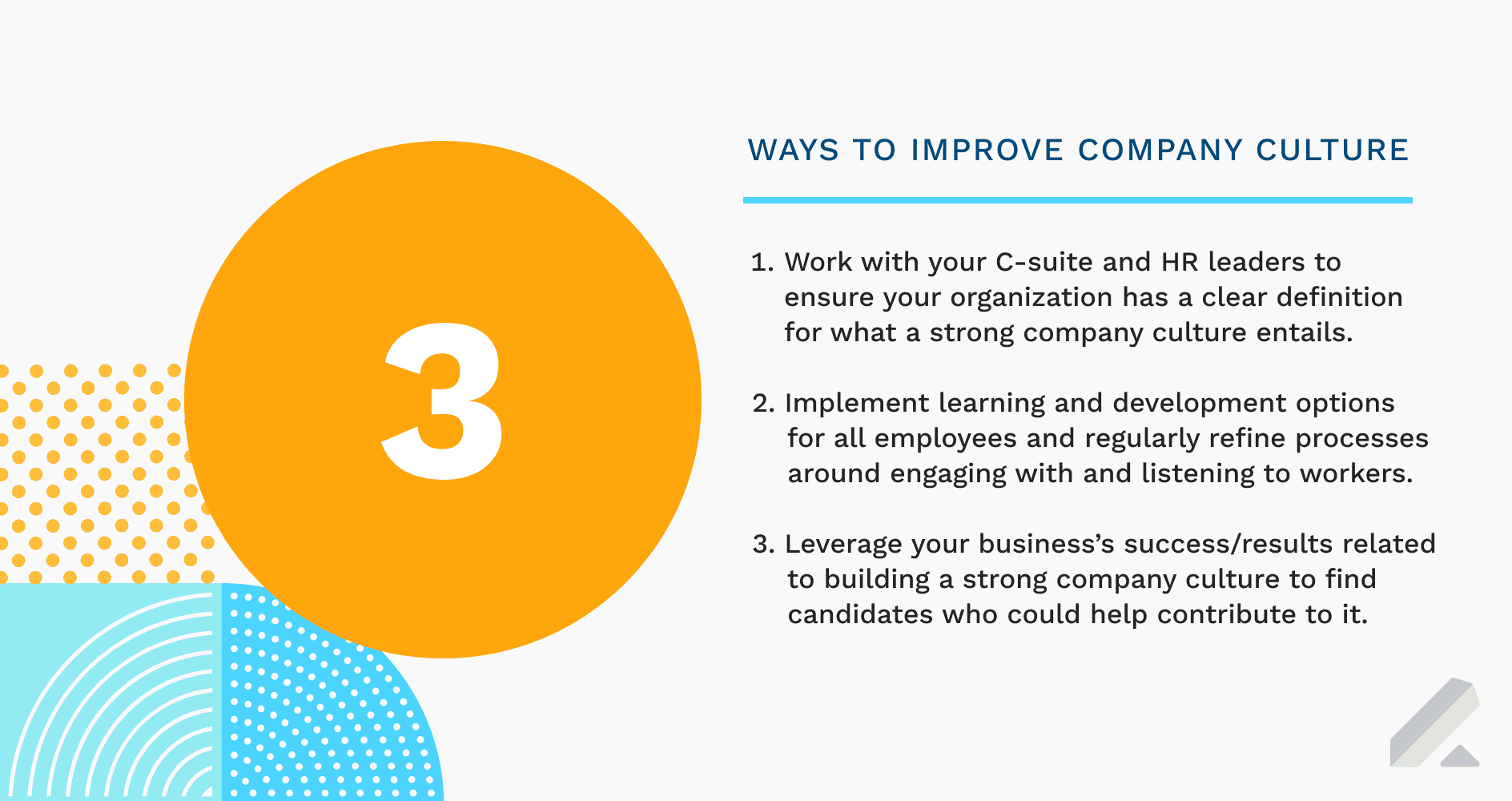‘How to improve company culture’ may not seem like a talent acquisition task at first glance.
However, given TA’s role in attracting and engaging high-quality candidates, the team certainly plays a role in shaping their company’s culture, albeit indirectly.
Of course, it’s not solely on talent acquisition leaders and their recruiters.
Human resources needs to hold up its end of the bargain by doing its part to do things like implement employee recognition programs, help shape the company’s mission statement, and build a workplace culture that makes employees feel seen and heard.
Only when both TA and HR work in tandem (while liaising with their leadership team) can they build a truly enviable organizational culture. (Particularly one that prioritizes DEI.)
More specifically, a culture that leads to low turnover rates (i.e., high employee retention), offers flexible work for employees, and gets staff members to not only evangelize the business publicly, but also even recruit for the company by sharing referrals.
How to improve company culture through a focus on innovation and the work environment at large
Innovative cultures are not an easy button. Companies must consider the rigor involved to develop and maintain such an environment, including strategic leadership and capable talent.
“Despite the fact that innovative cultures are desirable and that most leaders claim to understand what they entail, they are hard to create and sustain,” Harvard Business School Professor of Business Administration Gary P. Pisano wrote for Harvard Business Review.
This is because the well-received behaviors are “counterbalanced by some tougher and frankly less fun behaviors,” according to Pisano.
Tolerance for failure is counterbalanced by intolerance for incompetence. Experimental nature by rigorous discipline. Psychological safety by brutal candor. And so on.
As such, while most employees seek an innovative culture, it is imperative to identify and vet out talent that truly embraces these behaviors. Moreover, leadership must equip themselves with the blueprints and roadmaps to keep their talent innovators on track to meet the operational, marketing, and tech goals at hand.
This translates to setting talent acquisition up for long-term recruiting success.
Only when the team has the right people, processes, and tech can it capably (and consistently) identify and interact with top prospects for open positions and, by turns, help facilitate the hiring of workers who will contribute to the company’s goals and culture.
Once offers are accepted, the culture ‘baton’ is handed to HR. From here, it’s on them to execute the onboarding process to perfection to ensure new staff members are highly engaged from the get-go and ready to hit the ground running in their respective roles.

Learning and development and process refinement key to company culture improvement
That’s how you set the foundation for a strong company culture. Sustaining it is another matter.
Companies that don’t regularly enhance and improve processes and offer learning and development options to employees often find themselves struggling with productivity and quality outcomes, both from a talent acquisition and retention perspective.
Consider Salesforce. The business offers learning and development programs during onboarding to improve new-employee performance.
The company also has the Chatter app for internal engagement and learning from colleagues, live training with third-party websites, and personal training by Salesforce experts.
What’s more, the org incentivizes existing staff members to train new workers through a credit and reward system, which leads to high employee engagement.
“When you help people to grow and develop, the outcome is a winning trifecta: Knowledge workers find fulfillment, the customer experience is magnified, and the business thrives in rapidly changing economies,” concludes Marcel Schwantes wrote for Inc.
This is certainly an initiative that must be guided by execs and HR. It begs the question, though: Where does talent acquisition come into play with these efforts to improve company culture?
The answer? Regularly chat with HR team members to learn what facets of their culture they can promote in impact job descriptions and on their career site, about page, social media accounts, and job boards to bolster the employer brand and better attract top candidates.
Creating an unforgettably audacious company culture requires constant collaboration
Continuously engaging both passive and active candidates is the new norm in recruiting. (Especially in such a competitive marketplace.) This means being visible and vocal about your brand value across all digital channels as well as during in-person interactions.
Cultivating lasting relationships with talent that cross your company’s path helps ensure that when a hiring need arises, you have a strong talent pool to lean on.
This includes everything from the swag you leave behind with workplace visitors, to how you interact in the multifaceted social networking stream, to how you nurture candidates through one-on-one conversations in advance of the job requisition.
All in all, a data-backed approach to connecting with and converting candidates who could add to your (likely) already-stellar company culture means you and your talent team can contribute to business growth in the form of high employee satisfaction and retention.
Equally important, you can assist your counterparts in HR with what should really be a company-wide endeavor, not something that falls solely on their (already-busy) plate.
Find out how your HR and talent teams can work with one another to plan and execute a data-driven recruitment strategy by watching our on-demand webinar today.



